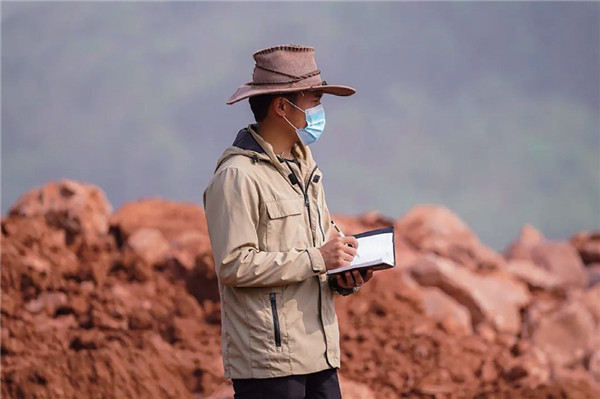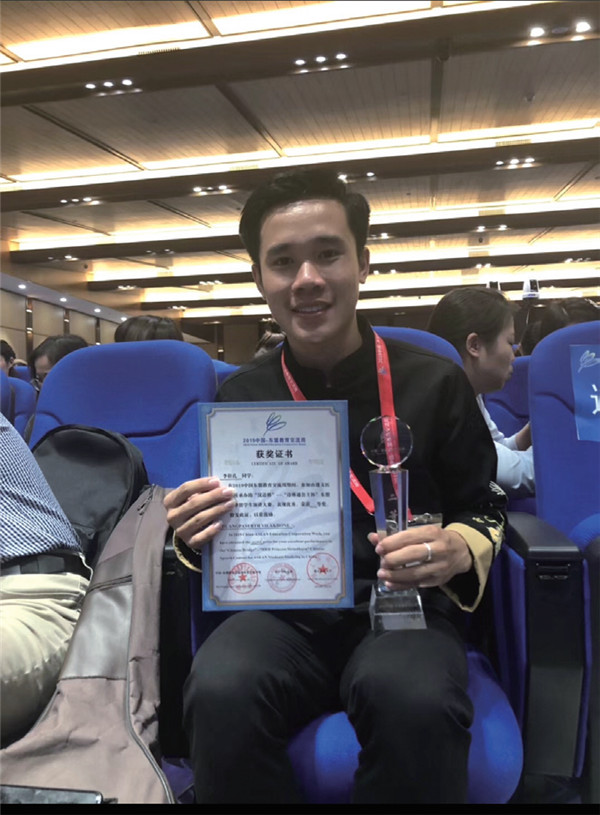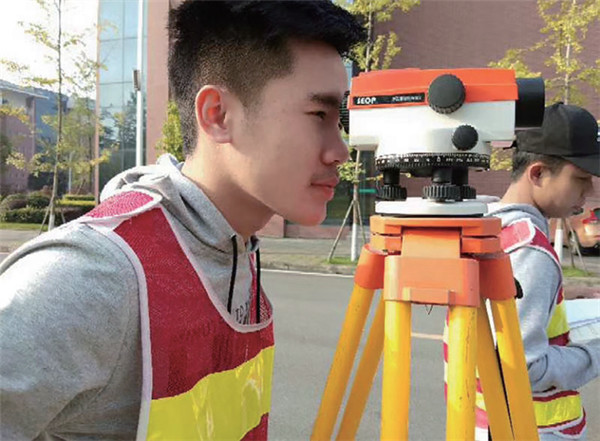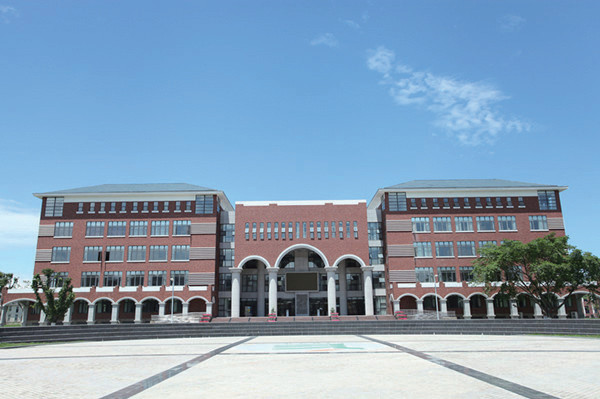心中的桥
[老挝] 李拉孔 成都纺织高等专科学校

有一天,爸爸指着门前的小桥说:“河对面有个超级大的国家,叫中国,有机会你一定要走过这座桥,到中国去寻找自己的梦想!”那是我第一次知道“中国”这个名字,爸爸的话从此就在我的心里扎根,埋下了深深的憧憬。
人们常说,念念不忘,必有回响!高中毕业后,我真的到了中国学习建筑工程,第一站便是天府之国成都。成都是一座平坦和充满活力的城市,虽然与老挝相比冬天很阴冷,但这里有热辣辣的火锅和川剧,充满了生活气息。这里还有热情的中国朋友,即便是还没熟练掌握中文的时候,我也从来不担心在大街上迷路。这里遍地都是自行车,仿佛是自行车的王国,出行十分方便。当然中国实在太大了,单是一个成都,让我觉得即便把余生都用来旅游,也看不完这里的风景。

李拉孔在老挝磨丁经济特 区的工作照
不过不用担心,高铁可以解决你的难题!四年间,我坐着高铁饱览了中国的大好河山,涌起激情无限。最让我难忘的是见识到了各种各样的桥,每一处都让我印象深刻,用朋友的话说,我像是刘姥姥进了大观园,看什么都新鲜!在江苏,我看到了小巧雅致的古石桥,静卧在园林湖面上,桥身全部用石头砌成,石栏上雕刻着各种精美图案,水中荷花盛开,鱼儿在荷叶下嬉戏,湖面楼阁倒映,十分好看;在湖北,我看到了公路铁路两用的武汉长江大桥,宏伟的桥梁飞架在两岸,桥面上是络绎不绝的汽车和行人,火车就在你的脚下呼啸而过,这种景象只想一想就足够神奇;在重庆,我看到了城市中各种各样的立交桥,就像丝带一般穿插缠绕,真令人眼花缭乱;在贵州,我还看到了一座连接一座令人震撼的高架桥,有的像彩虹,有的像帆船,还有的像灯塔,搭配着橙色、鲜红色、银白色等各种色彩,跨河越岭,点缀在青山绿水之间,自成一道道美丽的风景,让人不得不赞叹中国建筑技艺的高超和国力的强大。要知道,中国的道路桥梁工程可是全世界第一。每看到一座桥,我对建筑的理解就会提升一些,想象力也更加丰富。
中国古诗词里还有不少关于桥的诗句,有“伤心桥下春波绿,曾是惊鸿照影来”的哀婉;也有“两水夹明镜,双桥落彩虹”的唯美;更有“二十四桥明月夜,玉人何处教吹箫”的浪漫。这就是中国的桥,古老与现代交融,自然和人文搭配,洋溢着特有的美和蓬勃向上的气息。对中国人来说,桥已不仅仅是方便人们通行的建筑,每一座桥都有一个动人的故事。中国的桥梁之美,是促进我向汉语和中国文化深处探寻的源泉与动力。
我暗下决心好好学习,把先进的技术带回我的国家,让更多的人受益。中国文化博大精深,虽然专业课程安排得很满,但我仍然会挤出时间来学习汉语,我选修了很多中国传统文化课:国画、书法、篆刻等。我还参加了学校的朗诵比赛,当我穿着自己国家的民族服装,配着音乐,声情并茂地朗诵起曹操的《短歌行》的时候,那种感觉真是太酷了!

李拉孔在 2019 年“汉语桥”—“诗琳通公主杯” 东盟国家在华留学生演讲赛荣获“二等奖”
来中国的四年时间里,我开阔了眼界,在这里的每一天都过得忙碌而充实。有时夜里我也会想家,想琅南塔的小村子。每当这时候,故乡的小桥与中国的大桥就在我脑子里闪现,亲切而又遥远。但我知道自己还有很多事要做,还要去努力和坚持,梦想又伴着我快乐地入眠。
2020年春节,新冠肺炎疫情发生后,我又回到了老挝。因为疫情,我没能与老师和同学拍毕业照,这让我十分遗憾,但在中国的留学经历让我的人生受益匪浅,工作的磨炼更让我信心倍增。现在我在老挝磨丁经济特区工作,磨丁经济特区是“一带一路”中国—中南半岛经济走廊热土,与中国云南的西双版纳相邻。这里有很多来自中国的工程技术人员,因为既懂老挝语又熟悉汉语,我很快成了中老两国同事间的“红人”,我们正一起用建筑的语言和辛勤的汗水将中老文化巧妙地汇入磨丁的发展长河中。现在一座座大桥已经在老挝拔地而起,村子前那座小木桥仍然还在,但我心里明白,不久的将来它也一定会发生改变。

成都纺织高等专科学校教学楼 / 李拉孔提供
转眼回到老挝已经快两年了,我对在中国的学习经历依然充满了眷念。很庆幸自己人生中有一段青春岁月是在这个美丽的国家度过,尽管时光流逝,作为一名曾在中国留学的老挝人,我将永远感谢中国这方水土,感恩曾帮助和支持过我的中国人。回想在中国的点点滴滴,那些美好的场景依然历历在目。当前国际形势风云变幻,尤其是疫情发生后,中国受到了以美国为首的西方国家领导人的诘难,但我始终相信那么热情善良的中国人民和极度有责任感的中国政府永远是这个世界的光和希望。

李拉孔在学校学习建筑工程技术

成都纺织高等专科学校大学生活动中心 / 李拉孔提供
成都纺织高等专科学校图书馆 / 李拉孔提供
我曾看过一部中国电影,叫《摆渡人》,电影里的摆渡人是城市的超级英雄,他把人们从痛苦中解救出来,用爱和温暖抵抗这个世界的悲伤。我觉得这个摆渡人特别像中国在我心中的形象:以己之力,甘于奉献,同舟共济!美丽而伟大的中国又像一条大河,汇聚百川,心怀坦荡,正以不可阻挡的姿态流向远方!未来,希望自己也能成为这样的一位摆渡者,若中国是此岸,老挝是彼岸,那么我愿尽我所能,努力成为沟通彼此之间的一座桥梁!
Bridge in Heart
[Laos] Duangpaserth Vilakhone, Chengdu Textile College
When I was a child, my family lived in a small village in Luang Namtha, Laos. There was a small river in front of the village, which flew quietly. There was also a small bridge made of several long planks running across both sides, connecting the village and the outside world.It would creak and stagger as people walked on it. But at that time, it was my paradise there. Every summer, my friends in the village and I would spend the whole day in the river, catching fish, swimming and playing water fights. We are so happy that we often forgot to go home.
One day, my father pointed to the small bridge in front of the door and said, “There is a super big country across the river called China. When you have the opportunity, you must cross this bridge and go to China to seek your own dream!” It was the first time I knew the name “China”. Since then, my father’s words have taken root and buried a deep longing in my heart.
People often say, “Always remember, and there will be echoes!” After graduating from high school, I really went to China to study construction engineering. My first stop was Chengdu, the land of abundance. Chengdu is a flat and vibrant city. Although it is humid and cold in winter compared with Laos, there are hotpot and Sichuan Opera in Chengdu, which is full of the taste of life. There are also many enthusiastic Chinese friends. Even when I was not proficient in Chinese, I never worried about getting lost in the street. Bicycles are everywhere here, like in a kingdom of bicycles, making it very convenient to travel. China is certainly large. Even Chengdu alone has more scenery than I can see even if the rest of my life were spent in traveling.
But don’t worry! The high-speed railway can solve your problem! During my four years in China, I rode the high-speed railway and enjoyed the wonderful rivers and mountains of China, which inspired boundless passion in my heart. What most unforgettable is all kinds of bridges that I saw. Every place impressed me deeply. In my friends’ words, I was like Grandma Liu entering the Grand View Garden and everything seemed fresh to me! In Jiangsu, I saw small and elegant ancient stone bridges, lying quietly on the surface of the garden lake. They are all made of stone, carved with various exquisite patterns on the stone fences. The lotus flowers in the water were fully blooming, the fish were playing under the lotus leaves, and the pavilions were reflected on the lake, which were all beautiful. In Hubei, I saw the Wuhan Yangtze River Bridge, which is both for highway and railway. The magnificent bridge flies across both sides, on which cars and pedestrians were in constant flow, and under which the train was roaring under your feet. It is magical enough just to think about it. In Chongqing, I saw all kinds of overpasses in the city, intertwined like ribbons, making people dazzle. In Guizhou, I also saw viaducts connecting viaducts, some like rainbows, some like sailboats, and some like lighthouses, decorated with various colors such as orange, bright red, silver and white, etc., stretching over rivers and ridges, dotting the green mountains and waters, and making themselves beautiful scenery. We have to admire the superb skills of Chinese architecture and the strength of the country. You know, China’s road and bridge projects have the first place in the world. Every time I saw a bridge, I would have a better understanding of architecture and my imagination would also become richer.
There are many moving poems about bridges in ancient Chinese poetry, such as the sad lines: “It’s sad to see the spring water flowing green under the bridge, in which her stunning beauty was once reflected;” the aesthetic lines: “Two waters hold a mirror-like lake, two bridges fall like rainbows;” and the romantic lines: “On the twenty-fourth bridge on the moon-lit night, where are the beauties who played the flute?” This is China’s bridge, blended with antiquity and modernity, mixed with nature and humanism, and permeated with unique beauty and vibrant atmosphere. For the Chinese, the bridge is not only a convenient building for people to pass through, but each has its moving story. The beauty of Chinese bridges was the source and motivation for me to explore the depths of the Chinese language and Chinese culture.
I made my mind to study hard and bring advanced technology back to my home country to benefit more people. Chinese culture is broad and profound. Although my major courses were very fully scheduled, I would still try to find time to learn Chinese. I took many optional courses in traditional Chinese culture: traditional Chinese painting, calligraphy, seal cutting and so on. I also took part in the school’s recitation competition. It was so cool when I recited Cao Cao’s “A Short-Song Ballad” with emotion accompanied by music in my own national costume.
In the four years when I was China, I broadened my horizon. Every day here was busy and fulfilled. Sometimes at night I would be homesick and miss the small village of Luang Namtha. At such moment, my hometown bridge would appear on top of the Chinese bridges, warm and remote. But I knew that I still had a lot of things to do, and had to work hard and persevere. Then dream would come back in my happy sleep again.
After COVID-19 broke out during the Spring Festival in 2020, I returned to Laos. I am very regretful that I wasn’t able to take graduation photos with my teachers and classmates because of the epidemic, but my experience of studying in China has benefited me a lot and my work experience there has also boosted my confidence. Now I work in the Boten Special Economic Zone in Laos, which is a hot land on the China-Indochina Peninsula Economic Corridor of the “Belt and Road Initiative” adjacent to Xishuangbanna in Yunnan, China. Here, there are many engineers and technicians from China. Because I know both Lao and Chinese, I soon became a “celebrity” between my colleagues in China and Laos. Together, we are skillfully merging Chinese and Lao culture into the long river of Boten’s development with the language of architecture and industrious sweat. Now bridges have sprung up in Laos. The small wooden bridge in front of the village is still there, but I know that it will change in the near future.
It has been almost two years since I returned to Laos, and I am still full of nostalgia for my studying experience in China. I feel very lucky that I have spent a period of youth in this beautiful country. Regardless of the lapse of time, as a Laotian who has studied in China, I will always be grateful to China and to the Chinese people who have helped and supported me. Looking back on the dribs and drabs in China, those beautiful scenes are still fresh in my mind. The current international situation is ever-changing, and, China, particularly after the outbreak of the epidemic, has been heckled by the leaders of Western countries led by the United States. But I always believe that the warm and kind-hearted Chinese people and the extremely responsible Chinese government will always be the light and hope of the world.
I once saw a Chinese movie calledThe Ferryman, in which the ferryman is a superhero of the city, who rescues people from their pain and resists the sadness of the world with love and warmth. I think this ferryman is very much like the image of China in my heart: use his own strength, dedicate himself to contribution, and help each other! The beautiful and great China is like a big river, accepting all streams with an open heart and flowing into the distance irresistibly! In the future, I hope I can also be such a ferryman. If China is this side and Laos is the other side, then I would like to try all my best to become a bridge connecting each other!



